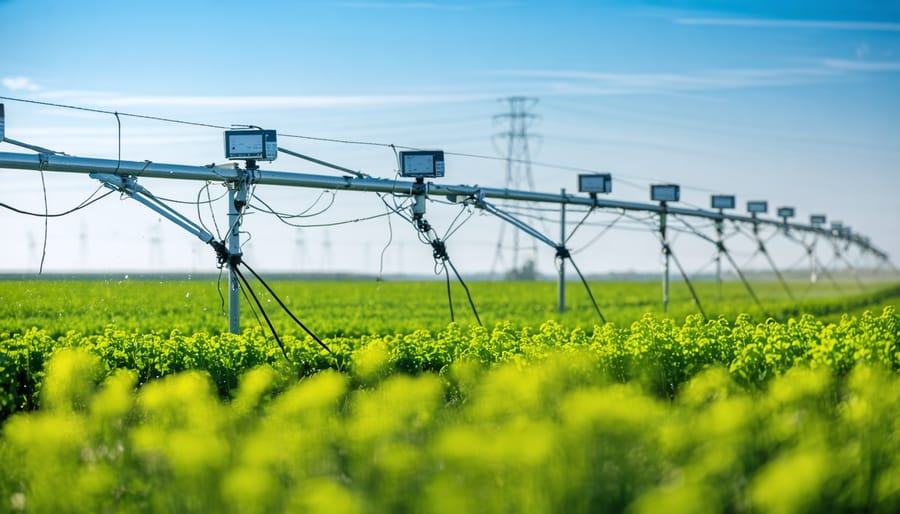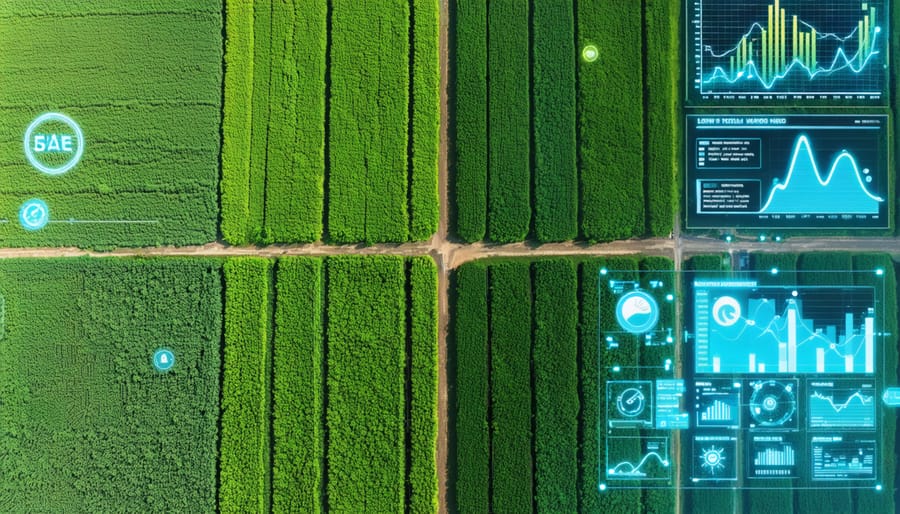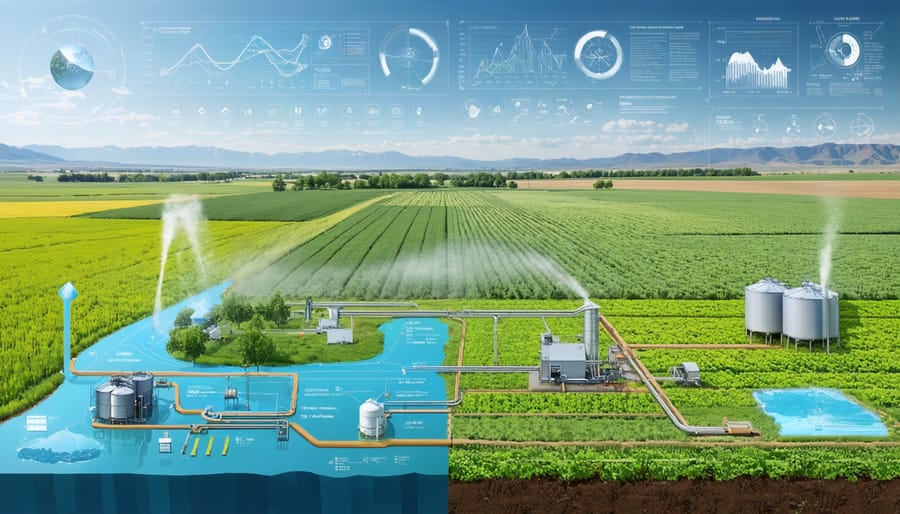Solar-powered desalination stands as a game-changing solution for water challenges faced by Alberta farmers, transforming brackish groundwater into a reliable irrigation source. This innovative technology harnesses Alberta’s abundant sunshine – averaging 2,300 hours annually – to produce fresh water at operating costs 60% lower than traditional electric systems. By integrating solar thermal collectors with membrane distillation units, farmers can process up to 1,000 litres daily while maintaining organic certification standards. Recent field trials across Southern Alberta demonstrate successful implementation on farms as small as 40 hectares, with systems paying for themselves within 3-5 growing seasons through reduced water procurement costs and increased crop yields. As drought conditions intensify across the prairies, this sustainable approach offers Alberta’s agricultural community a practical path toward water security without compromising organic farming principles.
How Solar Desalination Works in Agricultural Settings
The Basic Process
Solar-powered desalination works much like nature’s water cycle, but in a controlled environment. Think of it as a greenhouse effect in a smaller, more efficient package. The process starts when sunlight hits a water-filled container or basin, typically made of dark-coloured material to absorb maximum heat.
As the sun warms the water, it begins to evaporate, leaving behind salt and other minerals. This is similar to how puddles dry up after a summer rain, but we’re capturing that water vapour instead of letting it escape. The vapour rises and meets a cooler surface – usually a sloped piece of glass or plastic – where it condenses into freshwater droplets.
Here in Alberta, we can maximize this process by using south-facing installations to catch the most sunlight, especially during our longer summer days. The condensed water then runs down the sloped surface and collects in a separate container, ready for use in your farming operations.
The beauty of this system is its simplicity – there are no complex moving parts, and it relies entirely on natural processes. While the basic concept hasn’t changed much since our grandparents’ time, modern materials and designs have made these systems much more efficient. For every litre of saltwater, you can typically expect to collect about 4-6 litres of fresh water per square metre of collection area on a sunny day.

Integration with Organic Farming Systems
Solar-powered desalination systems seamlessly integrate with organic farming operations, complementing existing water-smart practices while maintaining organic certification standards. These systems provide a sustainable water source without introducing synthetic chemicals or compromising soil health.
For Alberta’s organic farmers, the integration process typically begins by connecting desalination units to existing irrigation systems. The purified water can be mixed with other water sources to achieve optimal mineral content for different crops. This flexibility allows farmers to adjust water quality based on specific crop needs and soil conditions.
Many organic operations in southern Alberta have successfully incorporated these systems into their greenhouse operations and field irrigation. The solar-powered aspect aligns perfectly with organic principles of reducing fossil fuel dependency and maintaining a lower carbon footprint.
The integration also supports crop rotation and soil building practices. Clean water helps prevent salt buildup in soil, particularly important for regions dealing with naturally occurring soil salinity. Farmers can use the concentrated brine byproduct responsibly by directing it to salt-tolerant areas or implementing proper disposal methods that align with organic standards.
Local success stories include several Medicine Hat area farms that have reduced their reliance on municipal water sources while maintaining organic certification. These farmers report improved crop quality and better control over their water management systems.
Benefits for Alberta’s Organic Farmers
Water Quality Enhancement
Solar-powered desalination systems significantly improve water quality for agricultural use, offering Alberta farmers a sustainable solution for crop irrigation challenges. The purified water from these systems contains optimal mineral content, which promotes better soil health and crop development. By removing excess salts and harmful compounds, the technology helps prevent soil salinization, a common issue in our prairie regions.
Local farmers report notable improvements in crop yields when using desalinated water, particularly for salt-sensitive crops like pulses and vegetables. The treated water also helps maintain proper soil structure and supports beneficial microbial activity in the root zone. This is especially valuable for organic operations where maintaining natural soil ecosystems is paramount.
Recent field trials in Southern Alberta demonstrated that crops irrigated with desalinated water showed improved nutrient uptake and required less frequent irrigation compared to those using untreated water sources. The system’s ability to maintain consistent water quality throughout the growing season provides farmers with reliable irrigation planning capabilities, essential for sustainable farm management.
Energy Cost Reduction
Implementing solar-powered desalination can significantly reduce operational costs for Alberta farmers, particularly in areas where water treatment is a substantial expense. Based on data from local agricultural operations, farmers can expect to see a 40-60% reduction in energy costs compared to traditional grid-powered desalination systems.
A typical 50-hectare farm using solar-powered desalination can save approximately $12,000 to $15,000 annually on energy costs. These savings become even more significant when considering the federal and provincial clean energy incentives available to Canadian farmers adopting sustainable technologies.
Beyond direct cost savings, solar-powered systems offer valuable energy independence. During peak summer months, when both irrigation needs and solar potential are highest, farmers can operate their desalination systems without drawing from the grid. This independence provides a buffer against rising energy prices and potential power outages.
Many Alberta farmers report that their systems pay for themselves within 5-7 years through reduced energy costs, while the systems typically last 20-25 years with proper maintenance. This long-term investment perspective has made solar-powered desalination an increasingly attractive option for forward-thinking agricultural operations.
Environmental Impact
Solar-powered desalination stands out as a shining example of sustainable water treatment in Alberta’s agricultural sector. By harnessing the sun’s energy, these systems significantly reduce the carbon footprint associated with traditional water treatment methods, which typically rely on fossil fuels or grid electricity.
A typical solar-powered desalination system in Alberta can offset approximately 5.2 tonnes of CO2 emissions annually compared to conventional electric-powered systems. This reduction is particularly meaningful for our province’s commitment to environmental stewardship and sustainable farming practices.
Beyond carbon reduction, these systems create minimal waste and environmental impact. The brine produced during desalination can be managed responsibly through evaporation ponds or, in some cases, repurposed for other agricultural uses. Many Alberta farmers have reported that the salt harvested from the process can be used as mineral supplements for livestock.
The systems also support local wildlife by reducing pressure on natural freshwater sources. Several farming operations near Lethbridge have noted increased bird activity around their solar installations, demonstrating how sustainable technology can create unexpected benefits for local ecosystems.

Real Success Stories: Alberta Farmers Leading the Way
Meet Ron Thompson, a third-generation farmer from Lethbridge County, who transformed his struggling 800-hectare operation into a model of sustainable agriculture using solar desalination. “Three years ago, our soil salinity issues were threatening our crop yields,” Ron explains. “Now, we’re seeing better production than ever, and our water costs have dropped by 60%.”
Ron’s solar desalination system, installed in 2020, processes 50,000 litres of brackish groundwater daily, providing clean irrigation water for his organic wheat and pulse crops. The system paid for itself within two years through reduced water purchasing costs and improved crop yields.
In Brooks, Alberta, Sarah Chen and her family operate a 15-hectare greenhouse operation where solar desalination has revolutionized their water management. “Before implementing solar desalination, we struggled with mineral buildup in our hydroponic systems,” Sarah shares. “Now we maintain optimal water quality year-round, and our energy costs are minimal thanks to the solar component.”
The Chen family’s system combines solar thermal and photovoltaic technologies, treating both groundwater and recycling greenhouse runoff. Their success has inspired five neighboring farms to adopt similar systems.
Further north in Sturgeon County, the Martinez Family Cooperative showcases how smaller operations can benefit from solar desalination. Their 200-hectare mixed farming operation installed a modular system that can be scaled according to seasonal needs. “We started with a small unit treating 5,000 litres per day,” explains Maria Martinez. “The results were so positive that we’ve expanded twice since then.”
The cooperative’s innovative approach includes a water-sharing agreement with neighboring farms, maximizing the system’s efficiency and creating a model for community-based water management. Their initiative has received recognition from the Alberta Agricultural Sustainability Board for demonstrating excellence in water conservation.
These success stories share common elements: careful planning, community engagement, and a commitment to sustainable practices. Each farm worked closely with local agricultural extension services and renewable energy experts to design systems tailored to their specific needs and conditions.
The results speak for themselves: reduced operating costs, improved crop yields, and enhanced soil health. More importantly, these pioneers are proving that solar desalination is not just environmentally sound but economically viable for Alberta farmers of all scales.
Implementation Guide: Getting Started
System Selection and Sizing
When selecting a solar-powered desalination system for your farm, several key factors need consideration to ensure optimal performance and return on investment. The size of your operation, water quality requirements, and available solar resources in your area will guide your choice.
For most Alberta farms, a system capable of processing 1,000 to 5,000 litres per day is typically sufficient for irrigation needs. Consider your peak water demands during summer months and factor in a 20% buffer capacity. The system should integrate seamlessly with your existing water conservation strategies while maintaining consistent output throughout the season.
Solar panel capacity should match your desalination unit’s power requirements. For every 1,000 litres of daily processing capacity, plan for approximately 2-3 kW of solar power installation. Alberta’s abundant sunshine makes this particularly feasible, with most regions receiving 2,300+ hours of annual sunshine.
Look for systems with proven track records in similar climates. Reverse osmosis (RO) units paired with solar photovoltaic panels are currently the most reliable configuration for our region. Choose systems with automated monitoring capabilities and basic maintenance requirements that align with your farm’s operational schedule.
Consider scalable solutions that allow for future expansion. Many manufacturers offer modular systems that can grow with your needs while maintaining efficiency and cost-effectiveness.

Installation and Maintenance Tips
For successful installation of a solar-powered desalination system, start by conducting a thorough site assessment to determine optimal solar panel placement. In Alberta’s climate, positioning panels at a 45-degree angle facing south typically yields the best results. Ensure your installation area can support the system’s weight, particularly when tanks are full.
Regular maintenance is crucial for system longevity. Clean solar panels monthly during the growing season, paying special attention after dust storms or heavy pollen periods. In winter, remove snow accumulation promptly to maintain efficiency. Check and clean filters every two weeks during peak operation to prevent membrane fouling.
Monitor water quality weekly using basic testing kits available at most agricultural supply stores. Keep detailed maintenance logs to track system performance and identify potential issues early. Inspect seals and connections quarterly, and replace membranes every 3-5 years depending on usage and water quality.
For Alberta farmers, we recommend installing freeze protection measures, including insulation for pipes and tanks. Consider building a simple shelter around critical components to protect against severe weather. Have backup power options ready for essential operations during extended cloudy periods.
Store essential spare parts on-hand, including filters and basic repair materials. Connect with local solar installation experts for annual professional inspections, and consider joining regional farming networks to share maintenance tips and experiences with other system owners.
Solar-powered desalination represents a game-changing opportunity for Alberta’s organic farming community. As our province continues to face water scarcity challenges, this innovative technology offers a sustainable solution that aligns perfectly with organic farming principles. The combination of Alberta’s abundant solar resources and the growing demand for organic produce creates an ideal environment for implementing these systems.
Looking ahead, the potential for solar desalination in our agricultural sector is immense. Not only does it provide a reliable source of clean irrigation water, but it also helps farmers reduce their environmental impact while maintaining organic certification standards. The success stories we’ve seen from early adopters in Southern Alberta demonstrate that these systems can be both economically viable and environmentally responsible.
For our farming community, embracing solar desalination technology means taking control of our water security while contributing to a more sustainable agricultural future. With continued support from agricultural organizations, growing expertise in implementation, and increasing affordability of solar technology, the path forward is clear. Together, we can build a resilient organic farming sector that thrives even in challenging climate conditions.










